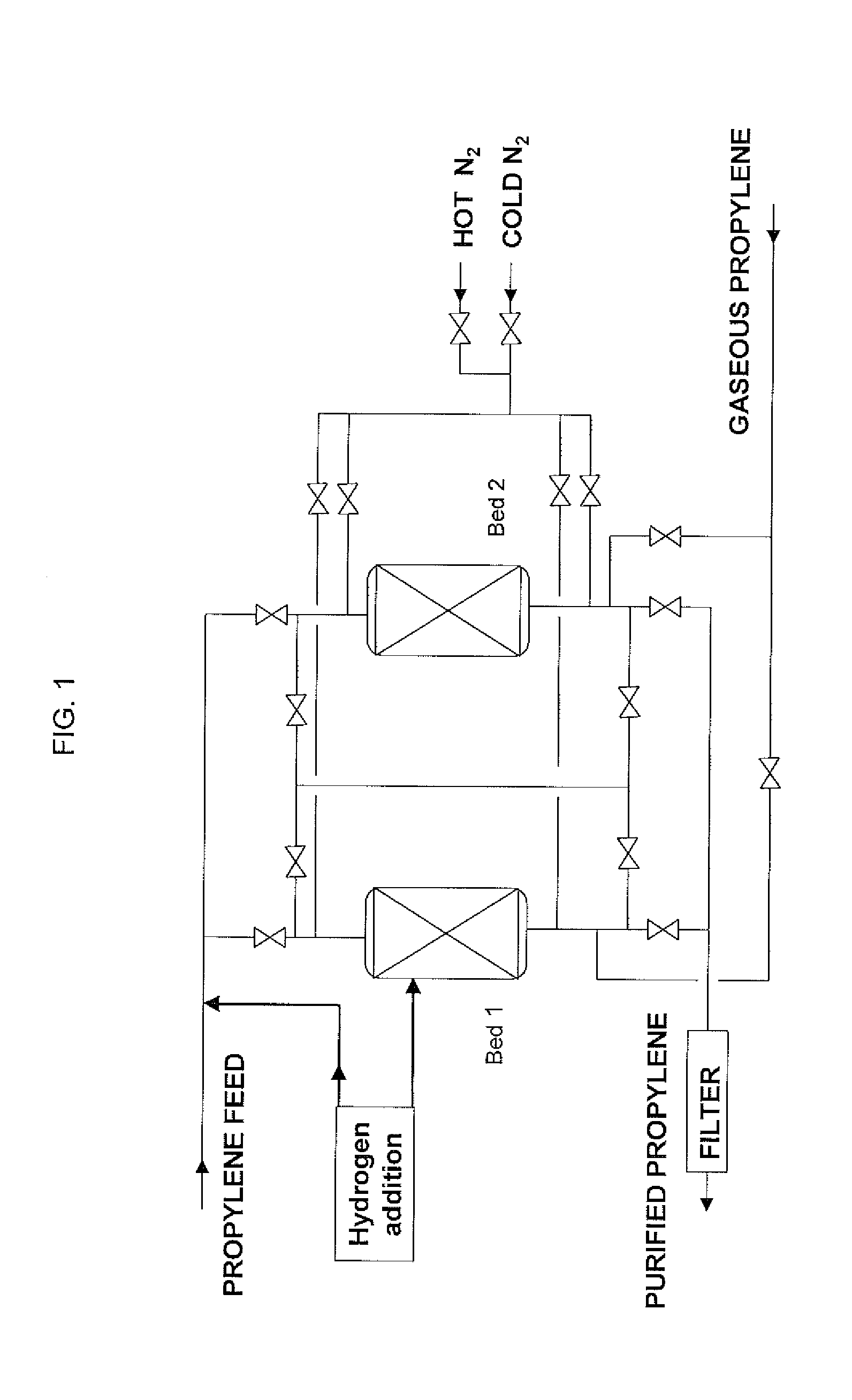Method to purify olefin-containing hydrocarbon feedstocks
a technology of olefin-containing hydrocarbons and feedstocks, which is applied in the field of process for the reduction of acetylenics and diolefins in propylene feedstocks, can solve the problems of contaminating the target olefin stream, affecting the quality of olefin, so as to achieve the effect of increasing the cost of replacemen
- Summary
- Abstract
- Description
- Claims
- Application Information
AI Technical Summary
Benefits of technology
Problems solved by technology
Method used
Image
Examples
example 1
Propylene Purification in a Single Metallic Nickel / Nickel Oxide Bed
[0048]Hydrogen was introduced into a liquid feedstock of polymer grade propylene containing 39 ppm of MAPD (28 ppm mol methylacetylene and 11 ppm mol propadiene). The feedstock was then passed in the upflow mode at a feed rate of 510 g / h over a catalyst bed material comprising metallic nickel / nickel oxide deposited on a silica-alumina support in bed 1 having the following properties:[0049]a weight ratio of metallic nickel to nickel oxide of 0.5 and a total weight of metallic nickel and nickel oxide being 50% of the weight of the catalyst bed material[0050]specific surface area of 150 m2 / g[0051]bulk density of 0.80 g / cm3 [0052]shaped as 1 / 16″ extrudates
[0053]The hydrogen flow into the propylene feedstock was steadily increased from 1 to 10 Nl / h. The feedstock was passed over the catalyst bed material at a temperature of 20° C., under a pressure of 17 barg, and an LHSV of 20 l / l.h. Thus, 5000 ppm mol of hydrogen was re...
example 2
Propylene Purification in Two Nickel / Nickel Oxide Beds in Series
[0055]Hydrogen was introduced into a liquid feedstock of polymer grade propylene containing 10 ppm of MAPD (7 ppm mol methylacetylene and 3 ppm mol propadiene). The feedstock was then passed in the upflow mode at a feed rate of 765 g / h over a first catalyst bed material in bed 1, having the same properties as the catalyst bed material in Example 1, followed by an identical second catalyst bed material in bed 2 at a feed rate of 688 g / h. This system is illustrated in FIG. 1.
[0056]The feedstock was passed over both catalyst bed materials at a temperature of 20° C., under a pressure of 17 barg, and an LHSV of 20 l / l.h. In order to substantially hydrogenate the MAPD in the feedstock, 7000 ppm mol of hydrogen was required. Results of the propylene feedstock recovered from bed 2 are provided in Table II.
TABLE IIRecoveredInitialpropylenepropylenefeedstockConversionCompositionfeedstock(outlet bed 2)in mol %Propylene [wt. %]97.8...
PUM
| Property | Measurement | Unit |
|---|---|---|
| Temperature | aaaaa | aaaaa |
| Temperature | aaaaa | aaaaa |
| Temperature | aaaaa | aaaaa |
Abstract
Description
Claims
Application Information
 Login to View More
Login to View More - R&D
- Intellectual Property
- Life Sciences
- Materials
- Tech Scout
- Unparalleled Data Quality
- Higher Quality Content
- 60% Fewer Hallucinations
Browse by: Latest US Patents, China's latest patents, Technical Efficacy Thesaurus, Application Domain, Technology Topic, Popular Technical Reports.
© 2025 PatSnap. All rights reserved.Legal|Privacy policy|Modern Slavery Act Transparency Statement|Sitemap|About US| Contact US: help@patsnap.com

